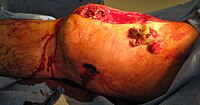
Photo from wikipedia
Objectives This time-motion study explored the amount of time clinicians spent on wound assessments in a real-world environment using wound assessment digital application utilizing Artificial Intelligence (AI) vs. manual methods.… Click to show full abstract
Objectives This time-motion study explored the amount of time clinicians spent on wound assessments in a real-world environment using wound assessment digital application utilizing Artificial Intelligence (AI) vs. manual methods. The study also aimed at comparing the proportion of captured quality wound images on the first attempt by the assessment method. Methods Clinicians practicing at Valley Wound Center who agreed to join the study were asked to record the time needed to complete wound assessment activities for patients with active wounds referred for a routine evaluation on the follow-up days at the clinic. Assessment activities included: labelling wounds, capturing images, measuring wounds, calculating surface areas, and transferring data into the patient’s record. Results A total of 91 patients with 115 wounds were assessed. The average time to capture and access wound image with the AI digital tool was significantly faster than a standard digital camera with an average of 62 seconds (P<0.001). The digital application was significantly faster by 77% at accurately measuring and calculating the wound surface area with an average of 45.05 seconds (P<0.001). Overall, the average time to complete a wound assessment using Swift was significantly faster by 79%. Using the AI application, the staff completed all steps in about half of the time (54%) normally spent on manual wound evaluation activities. Moreover, acquiring acceptable wound image was significantly more likely to be achieved the first time using the digital tool than the manual methods (92.2% vs. 75.7%, P<0.004). Conclusions Using the digital assessment tool saved significant time for clinicians in assessing wounds. It also successfully captured quality wound images at the first attempt.
Journal Title: PLoS ONE
Year Published: 2022
Link to full text (if available)
Share on Social Media: Sign Up to like & get
recommendations!